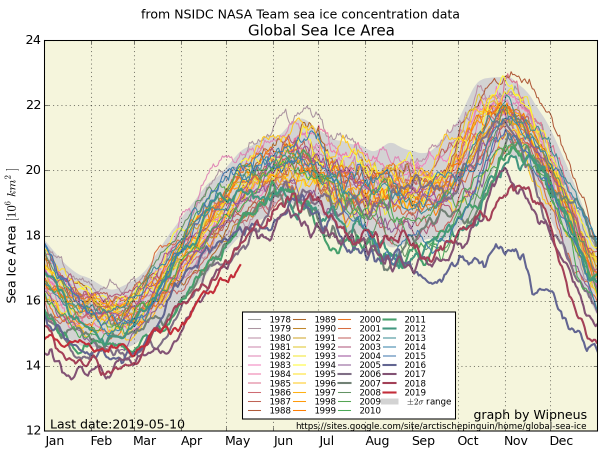As a weak El Nino combines with continued rising atmospheric greenhouse gas levels to push global temperatures higher in 2019, we are seeing some pretty extreme warming impacts the world over. Just one of these impacts involves sea ice.
(An analysis of factors contributing to global sea ice loss.)
Looking north, we already observe that Arctic sea ice is pretty much tied for lowest visible extent on record in the National Snow and Ice Data Center (NSIDC) measure. According to NSIDC’s Charctic Graph, sea ice extent in the Northern Hemisphere is ranging around 12.465 million square kilometers. This is just slightly above the record low for the date set in 2016 at 12.422 million square kilometers.
To the south, Antarctic sea ice extent has recently slipped into new record low ranges for this time of year. As of May 10th, NSIDC showed sea ice extent near the frozen southern continent in the range of 7.898 million square kilometers or about 200,000 square kilomters below the previous daily record low set in May of 2017. These record lows have occurred on the back of a rather warmer than normal late Southern Hemisphere Fall season.

(Global sea ice graph provided by Wipneus. Date provided by NSIDC.)
Two hemispheres experiencing record low or near record low sea ice conditions over an extended period during April through May of 2019 have now generated a historical period for global sea ice. The result is that recent major global sea ice losses occurring during 2016-2019 are being further solidified. Yet one more aspect of the larger global warming regime enforced by continued fossil fuel burning.
(Interested in fighting climate change on a personal level by switching to a clean energy vehicle? Get up to 5,000 free supercharger miles with this referral code.)







Marcel Guldemond
/ May 11, 2019Thanks for the summary Robert.
LikeLiked by 1 person
Abel Adamski
/ May 12, 2019Diverting a little from Ice to weather.
A record of 7000 years in South East Queensland. Interesting times ahead
Preserved leaves reveal 7000 years of rainfall and drought
https://phys.org/news/2019-02-reveal-years-rainfall-drought.html
“So, in effect, we can use leaf carbon isotope composition to infer rainfall through time. Since North Stradbroke Island is in a part of Australia that is very sensitive to ENSO, our study is able to document ENSO history.”
LikeLiked by 2 people